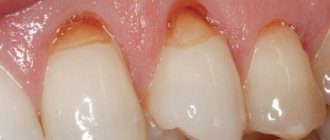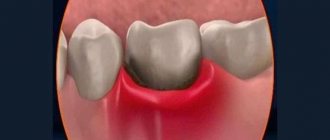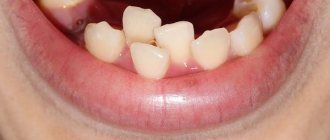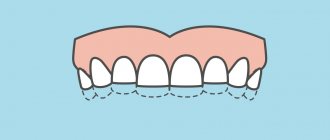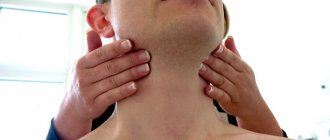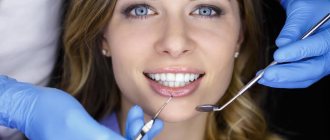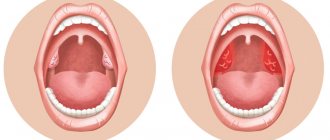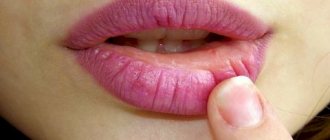21.11.2019
Children's baby teeth fall out and are replaced by permanent teeth. In rare cases, the first ones do not have time to fall out, but the second ones already grow nearby. This phenomenon received a specific name – “shark teeth”. Parents are always concerned about the question of what to do in such a situation.
Pathology mainly appears during the eruption of the lower central incisors. Less commonly, this happens with the growth of the upper incisors or molars.
Causes
A child's first teeth erupt in a certain order, starting at about six months of age. There are deviations in one direction or another, which is due to a number of factors (climate, drinking water) and the individual characteristics of the baby. For some, they appear as early as 1.5 months, for others - closer to a year. They fall out in the same sequence and are replaced with permanent ones. Complete replacement of the dentition occurs on average at the age of 12-13 years.
But there are also situations when permanent teeth begin to grow right next to the second row of milk teeth. If they are located in parallel, then this is called “shark teeth”. The name was coined by analogy with the anatomical feature of sharks. These predators have teeth arranged in three rows.
Possible reasons:
- genetics;
- improper formation of tooth germs during intrauterine development;
- rickets;
- infectious diseases (sinusitis, tonsillitis, adenoiditis).
Treatment
The appearance of a second set of teeth is a direct indication for visiting a pediatric dentist. However, you should not immediately tune in to a negative outcome. Correct treatment tactics completely eliminate this problem without developing any consequences. The main thing is early initiation of therapy and identification of the cause of the pathology. Further treatment tactics directly depend on the etiological factor:
- Extra milk tooth. Removal of the milk jug is the most common dental recommendation, after which correction of permanent teeth is not required. The indigenous “residents” are independently displaced into empty space. If this does not happen, the orthodontist corrects the position with a brace system, aligners or removable orthodontic structures. As a rule, baby teeth are removed in pairs, which affects the correct formation of the bite.
- Insufficient jaw development. The solution to this problem is artificial stimulation of development through removable or non-removable structures. The main difficulty of treatment is the young age of the young patient, which affects the care of prostheses. Invisalign, an elastic mouth guard that is simply put on and does not require special care, shows excellent therapeutic results.
- Hyperdontia. Treatment includes performing a maxillary X-ray, administering local anesthesia, removing the problematic tooth, and suturing the wound.
Why is it dangerous?
Despite the unattractive appearance of such a smile, there is no need to worry. Most often, dentists advise not to take any action. The root of the baby tooth softens, and the tooth falls out on its own after a certain period of time. The child facilitates this by loosening the tooth with his tongue or hands.
Despite the unattractive appearance of such a smile, there is no need to worry. Most often, dentists advise not to take any action. The root of the baby tooth softens, and the tooth falls out on its own after a certain period of time. The child facilitates this by loosening the tooth with his tongue or hands.
Possible consequences
There is usually nothing scary if a child has shark tooth syndrome. The problem mostly resolves itself. The milky roots become loose, gradually dissolve, the tooth becomes loose and falls out.
Children themselves, as a rule, participate in this process, loosening the “extra” tooth with their tongue or finger. But if the root is strong, resorption is slow, and the permanent unit has grown prematurely, some problems may arise:
- Distortion of the structure and shape of the gums.
- Pronunciation problems.
- Changing the position of existing teeth, i.e. can tilt or turn on an axis.
- Development of abnormal bite.
- Indigestion due to inadequate chewing of food or difficulty in taking it.
- Inflammation of the oral mucosa.
- Impaired salivation.
- Swelling of the nasal mucosa.
- Temperature increase.
Despite these consequences, children suffer ridicule from their peers most painfully, which becomes the cause of serious psychological discomfort.
The child stops communicating and smiles less often, which later turns into isolation and a feeling of inferiority.
Important: in order to exclude all of the listed consequences associated with the “shark jaw” syndrome, it is necessary to undergo regular examinations by a dentist to promptly exclude the development of complications.
The importance of proper breathing
Nasal breathing helps the jaws develop anatomically correctly. If you breathe through your mouth, there is a high risk of their underdevelopment. This fact can easily be explained by the fact that the tongue plays an important role in the formation of the jaws. In the first case, he takes the desired position. In the second case, the tongue is located at the bottom of the oral cavity and practically does not come into contact with the elements of the jaw arches. They do not develop properly and there is not enough space for permanent teeth.
The parents' job is to closely monitor their child's breathing. If nasal breathing is impaired during colds, a quick solution to the problem is required.
Therapeutic measures
Treatment tactics for “shark jaw” are always developed individually. The main thing for parents is to see the problem in time and not let it go.
If the second row does appear, experts recommend taking your time and waiting for a while. In 2-3 months, the roots of the milky elements can dissolve and they will fall out on their own.
Important: during this period it is necessary to carry out professional cleaning of the mouth, classical sanitation, rinsing with solutions and decoctions with an anti-inflammatory effect, monitor the hygienic condition of the mouth and remove sweets and excessively hard foods from the diet.
If the problem drags on for a long time, then doctors recommend extraction. This method is effective because the free space is quickly taken up by permanent elements. The same should be done if pain, change in enamel shade, swelling and inflammation appear in the area between the rows.
The process of teeth moving into the correct position after removal of excess units normally takes from 1 to 6 months. If after the specified period the situation does not change, orthodontic treatment is carried out using one of the types of structures:
- braces;
- aligners;
- kapp;
- retainers.
Important: modern diagnosis and a properly developed treatment plan allows you to avoid the development of a number of unfavorable situations and consequences.
Prevention
There is no such prevention that guarantees 100% prevention of anomalies in children. But there are several rules to help reduce risks. Here is their list
- Establishing proper nutrition with sufficient amounts of all vitamins and microelements. There should be solid foods that train the dentofacial apparatus.
- Timely treatment of oral diseases. Carious processes often lead to disruption of the development of the dental system.
- Correct nasal breathing.
- Regular visits to the dentist for preventive examinations and identification of possible problems.
If, when shark teeth appear in a child, the doctor advises removing a temporary tooth, do not be afraid of this. Modern dentists perform this procedure only when indicated and absolutely painlessly.
Concomitant pathologies
The appearance of another set of teeth is usually accompanied by other pathologies.
Supernumerary of teeth (hyperdontia)
A condition when additional tooth buds are present with fully formed dentition. This is a rare pathology, occurring in 5% of all people. It can occur with both temporary and permanent occlusion.
Additional bone formations can come out completely or remain in the hard jaw tissues, i.e., without appearing above the gum. They can grow as independent elements, or be combined with the front ones.
In practice, there are different locations of supernumerary units - on the hard palate, on either side of the jaw line.
In addition to deteriorating the overall aesthetics of the face, hyperdontia threatens the following problems:
- not tightly closing the lips and moving the jaw forward;
- difficulties with biting or completely chopping foods in the mouth;
- the difficulty of performing a hygienic procedure, due to the deterioration of which the likelihood of developing dental diseases sharply increases;
- speech impediment;
- malocclusion.
As a rule, one supernumerary element is identified. Anomalies with the appearance of 2 or more additional teeth are extremely rare .
Underdevelopment of the jaws
In dentistry, based on the clinical picture, there are several concepts of this phenomenon:
- micrognathia – the maxillary arch is underdeveloped;
- microgeny is the opposite phenomenon.
There are several reasons for the development of these defects. This includes poor nutrition of the mother during pregnancy, early loss of milk ducts, metabolic disorders in the fetus, and genetic heredity.
Disproportional development of the jaw arches is dangerous due to the development of:
- gastrointestinal diseases;
- heart pathologies;
- breathing difficulties;
- disorders of the central nervous system.
What treatment methods are used for deep bite in children and adults. In this publication we will discuss the treatment tactics for open bite.
Here https://dr-zubov.ru/ortodontiya/prikus/professionalnoe-sozdanie-krasivoj-ulybki-putem-xirurgicheskogo-ispravleniya.html we will tell you when surgical correction of the bite is prescribed.
How to normalize the position of dystopic fangs?
When choosing a technique, the orthodontist takes into account the severity and type of pathology, as well as the age of the patient. For children under 12 years of age, the use of specialized removable and non-removable structures is recommended:
- night guards worn at night;
- easy-to-maintain soft dental plates designed for long-term wear;
- trainers that target dentofacial defects.
The sooner the correction begins, the faster it will be possible to straighten teeth that are not yet fully formed. On average, the process takes 4–6 months.
Adolescents and adult patients need treatment with braces, which in severe cases will have to be worn for about two years.
How to understand that a child is at risk of growing teeth in two rows?
Attentive parents should monitor the process of teeth growth and loss. The change of dentition begins at 6-8 years: the first to fall out are the central and lateral incisors. At 9-11 years old, the lower canines change. By the age of 10-12, the upper canines and small molars grow. The formation of the bite ends at the age of 13-14 years.
A child’s tooth grows above the tooth when the baby tooth does not leave its place in due time. In this case, parents should definitely consult a doctor. The earlier the pathology is detected, the easier it is to correct the child’s second dentition.
You don’t have to wait for your baby teeth to suddenly fall out on their own! If you notice that your child’s molars are cutting in, but his baby teeth aren’t even loose yet, take him to the dentist. With “shark” teeth, not only the appearance, but also the shape of the jaw is disrupted.
Types of hyperdontia
Pathology is divided into several types depending on the factors that caused it and the location of unnecessary elements.
| Name | Description |
| Typical hyperdontia | Extra elements are located in the dentition |
| Atypical hyperdontia | Eruption in different places, for example in the sky |
| True polyodontia | The appearance of extra buds |
| False polyodontia | The proximity of permanent and milk elements of the masticatory apparatus |
Diagnostic methods
The main indication for diagnosis is the presence of an “extra” tooth in the patient’s oral cavity or obvious signs of its eruption (painful tubercle or swelling in the gum or palate). All of these signs can be identified through a routine visual examination, during which the dentist evaluates the condition of the oral cavity. To confirm the diagnosis and carry out differential diagnosis, an X-ray examination is performed - an orthopantomogram. If it is necessary to examine the dentition in several planes, computed tomography (CT) is additionally prescribed.
On a note! The patient may not be aware of the presence of impacted supernumerary teeth. In this case, hyperdontia is detected only by the results of an X-ray or CT scan of the maxillofacial region.
Reviews
The appearance of an additional row of teeth is a rare occurrence in dentistry, and in most cases it is a harmless problem that can be easily corrected.
Parents need to be more attentive to the child during the process of changing teeth, to notice the first problems in a timely manner, so that they can then deal with them effortlessly and quickly.
If you have encountered this phenomenon and would like to share your opinion and experience regarding its elimination, please leave a comment on this article.
If you find an error, please select a piece of text and press Ctrl+Enter.
